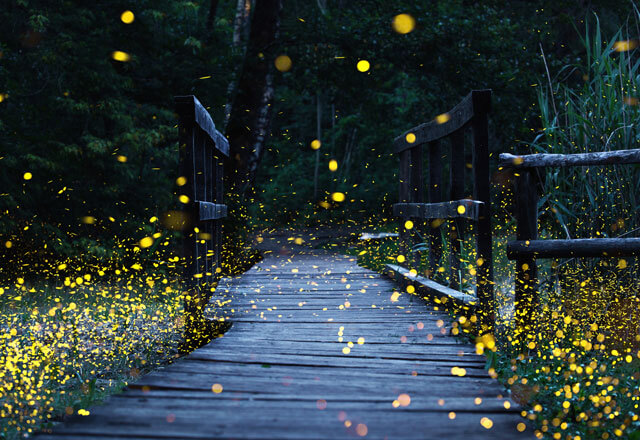I think we can all agree that there is something absurdly beautiful about an ephemeral speck of light; a glow you barely get to set your eyes on before it dissipates into thin air. Firefly season is upon us here in Baltimore, and, given that this was my first time seeing these tiny little creatures in person (at the age of 26!), I did a little research on them. Here’s an ode to the shooting stars of the Earth.
Fireflies, also known as lightning bugs or glowworms, are a family of insects in the beetle order. They have come to be known and loved for their bioluminescence, which refers to the production and emission of light by a living organism. There are over 2,000 species of fireflies across the globe, and while species are different, they have one thing in common: They love warm, humid environments. In the U.S., almost no species of fireflies are found west of Kansas despite many warm, humid areas in that part of the country, and no one has yet elucidated the reason for this absence. Fireflies are also nocturnal (lucky for us!) and love long grass. During the day, they spend most of their time on the ground, and at night, they crawl along the tops of blades of grass and fly into tree branches.
But how and why do fireflies glow? Put simply, fireflies have a special body part beneath their abdomen that utilizes oxygen from the atmosphere to emit light. While scientists have been able to detail the chemical reactions and steps involved in light production, they still haven’t determined how these insects can turn it on and off in a specific pattern. Scientists do know a lot about why fireflies flash, though: The light can serve as a warning to predators and drive them away, and fireflies also use it to communicate with each other and mark their territory. More importantly though, fireflies use that signal to attract and mate with other fireflies of the same species. Some fireflies are sly: Several species of the genus Photuris mimic female flashes of another species in order to attract and consume the males of that species. It’s not all sunshine and roses with these little bugs!
Interestingly, it was a Johns Hopkins University professor who discovered the role that a chemical called luciferase plays in helping fireflies light up. William McElroy was a research biologist who joined the JHU faculty in 1946 and initiated an independent research program in bioluminescence. His interest in fireflies came about serendipitously when he was a graduate student. In a 1989 interview, he said, "I had a cigar in my mouth and here we saw something coming at the light from the cigar, and it was one of these charging click beetles. They kept coming right at me." Throughout the years, he and his colleagues recruited as many as 30,000 Baltimore children to catch fireflies for their research, as fireflies were virtually impossible to breed in captivity.
Fireflies are so obviously and ostentatiously beautiful that they’re almost cheesy, and perhaps that’s why they’ve captured the hearts of many. When I was a kid, fireflies represented the world’s strangeness and beauty, and the absolute astonishment that life exists at all. As an adult, I hear their tune a little differently. What gets me about fireflies now is the fact that they make their own light; they glow where there would otherwise be darkness. And amidst the rollercoaster of the past two years, I find that notion very soothing. While we can certainly celebrate the light when we find it, perhaps we can also make our own when we don’t. That’s worth remembering.
References:
https://www.earth.com/earthpedia-articles/where-to-find-fireflies/
Related Content
- Summer Transitions: Learnings from Residency
- Have You Thanked an Oyster Today?
- A Homegrown Solution to a Homegrown Problem
Want to read more from the Johns Hopkins School of Medicine? Subscribe to the Biomedical Odyssey blog and receive new posts directly in your inbox.

Absolutely Delightful Piece Patrick! Thank you for reminding us that the light and beauty can sometimes come from within.
Beautiful! I wish I could have them in my garden 🙂
Comments are closed.